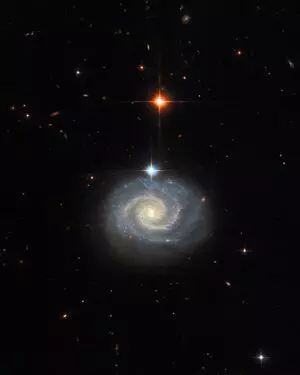
Galaxy with ‘forbidden’ light images by Hubble Telescope
text_fieldsWashington: A magnificent image of a dazzling spiral galaxy with "forbidden" light has been captured by the Hubble Space Telescope.
The galaxy, which goes by the name MCG-01-24-014, is roughly 275 million light-years away from Earth.
In addition to being a well-defined spiral galaxy, MCG-01-24-014 has an extremely energetic core known as an active galactic nucleus (AGN) and is categorised as a Type-2 Seyfert galaxy, said mission specialists from Hubble, managed by both NASA and European Space Agency.
Seyfert galaxies, along with quasars, host one of the most common subclasses of AGN.
While the precise categorisation of AGNs is nuanced, Seyfert galaxies tend to be relatively nearby and their central AGN does not outshine its host, while quasars are very distant AGNs with incredible luminosities that outshine their host galaxies.
There are further subclasses of both Seyfert galaxies and quasars. In the case of Seyfert galaxies, the predominant subcategories are Type-1 and Type-2.
Astronomers distinguish them by their spectra, the pattern that results when light is split into its constituent wavelengths.
The spectral lines that Type-2 Seyfert galaxies emit are associated with specific ‘forbidden’ emission lines. To understand why emitted light from a galaxy could be forbidden, it helps to understand why spectra exist in the first place.
Spectra look the way they do because certain atoms and molecules absorb and emit light at very specific wavelengths.
The reason for this is quantum physics: electrons (the tiny particles that orbit the nuclei of atoms and molecules) can only exist at very specific energies, and therefore electrons can only lose or gain very specific amounts of energy. These very specific amounts of energy correspond to the wavelengths of light that are absorbed or emitted.
Forbidden emission lines should not exist according to certain rules of quantum physics. But quantum physics is complex, and some of the rules used to predict it were formulated under laboratory conditions here on Earth, the team explained.
Under those rules, this emission is ‘forbidden’ -- so improbable that it’s disregarded. But in space, in the midst of an incredibly energetic galactic core, those assumptions don’t hold anymore, and the ‘forbidden’ light gets a chance to shine out toward us.
With inputs from IANS






